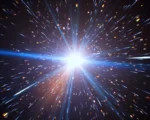Astronomers have recently observed the supermassive black hole at the center of the Milky Way, Sagittarius A*, emitting continuous flares, revealing new and intriguing behaviors in this cosmic giant. These observations were made using the James Webb Space Telescope (JWST), which provided unprecedented detail and clarity on the black hole’s activity. The flares, which vary in duration and intensity, add to the growing body of research on black holes, their accretion disks, and their interactions with surrounding matter. This discovery sheds light on a level of variability in Sagittarius A* that was previously not well understood, providing new insights into the dynamics of supermassive black holes.
The flares detected by JWST occurred over several observation sessions, totaling two full days of data collected during the past year. Using the telescope’s Near-Infrared Camera (NIRCam), researchers closely examined Sgr A* across multiple eight-to-ten-hour periods. The results were striking: the black hole produced bursts of energy ranging from quick, short-lived flashes to much longer, sustained outbursts. These bursts, occurring up to six times a day, were linked to the accretion disk surrounding the black hole, which is a dense ring of gas and dust spiraling inward. Some of these bursts were even accompanied by smaller sub-flares, further adding to the complexity of the black hole’s behavior.
While flares are a known phenomenon in supermassive black holes, the activity of Sgr A* is particularly unpredictable, setting it apart from other known black holes. The exact causes behind these flares are still being investigated, with scientists considering a variety of mechanisms. Shorter, fainter flares could be the result of small disturbances in the accretion disk, akin to ripples caused by minor disruptions. In contrast, the larger and brighter flares may be driven by more dramatic events, such as magnetic reconnection—an event in which charged particles accelerate to nearly the speed of light, producing powerful bursts of radiation.
Interestingly, the researchers compared the flaring activity of Sgr A* to solar flares, which are driven by magnetic activity on the sun’s surface. However, they noted that the processes near a black hole are far more extreme, with much greater forces at play. The NIRCam’s ability to observe multiple infrared wavelengths has proven invaluable in understanding these flares. It revealed a slight delay in the brightness of longer-wavelength emissions compared to shorter-wavelength ones, offering new clues about the complex mechanisms at work in the vicinity of the black hole. As research continues, these findings are helping scientists piece together a more complete picture of the behavior and characteristics of supermassive black holes.


















